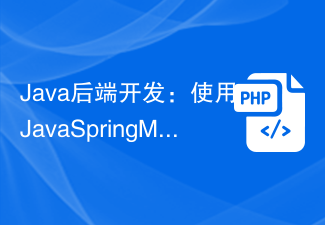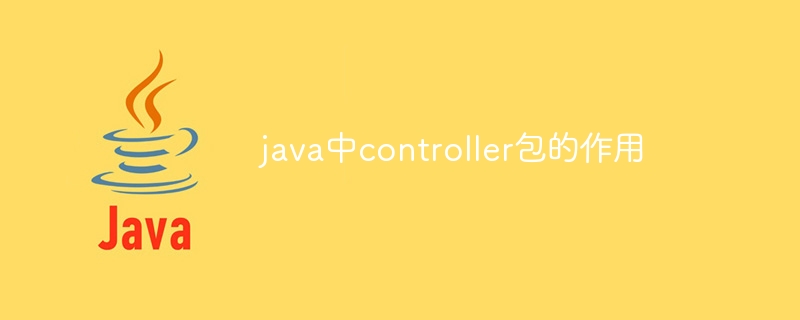Handler mapping in Spring MVC maps request URIs to handler methods. The process includes: receiving the request URI, parsing the request URI, and creating a HandlerExecutionChain object containing the handler method and request-response information. Its main components are: mapping registry, request matcher, handler adapter. A practical example showing how to use the RequestMapping annotation and handler mapping to map the request URI "/hello" to the hello() method.

Into Spring MVC handler mapping
Introduction
Spring MVC The handler map is an important component that is responsible for mapping requests to handler methods. This article will delve into how handler mapping works and demonstrate its use through a practical case.
The internal mechanism of handler mapping
Handler mapping is a key part of the request processing chain. Its responsibilities include:
- Receive the request URI
- Parse the request URI to determine the handler method
- Create a HandlerExecutionChain object that contains information about the handler method and request-response details
To To implement these functions, the handler mapping contains the following main components:
- Mapping registry: It stores the mapping relationship between the request URI and the handler method.
- Request matcher: It uses the request URI to find a mapping entry that matches it.
- Handler Adapter: It wraps handler methods into HandlerExecutionChain objects so that the Spring MVC framework can call them.
Practical case
To demonstrate handler mapping, we create a simple Spring MVC controller:
@Controller
public class MyController {
@RequestMapping("/hello")
public String hello() {
return "hello";
}
}In In the RequestMapping annotation, we specify that the request URI "/hello" is mapped to the hello() method.
In the Spring MVC configuration, we need to configure the handler mapping:
<mvc:annotation-driven/>
This configuration enables Spring MVC's annotation-driven support, which includes handler mapping.
When a request arrives at the URI "/hello", the handler mapping does the following:
- Parses the request URI and finds the matching mapping entry, which is "/hello".
- Use a request matcher to determine the handler method, which is
hello(). - Create a HandlerExecutionChain object containing the
hello()method and request-response details.
Spring MVC will then call the hello() method and return the "hello" view.
Conclusion
Handler mapping in Spring MVC is a complex but powerful component that is responsible for mapping requests to handler methods. By understanding its internals and how to use it, you can create scalable and robust web applications.
The above is the detailed content of How does handler mapping work in Spring MVC?. For more information, please follow other related articles on the PHP Chinese website!
 Java后端开发:使用Java Spring MVC进行API MVC框架开发Jun 17, 2023 am 10:27 AM
Java后端开发:使用Java Spring MVC进行API MVC框架开发Jun 17, 2023 am 10:27 AMJava后端开发是一种非常重要的技术,它是现代互联网应用程序的核心。Java后端开发主要涉及APIMVC框架开发。在这篇文章中,我将介绍如何使用JavaSpringMVC进行APIMVC框架开发。JavaSpringMVC是一个非常强大的开源框架,它主要用于Web应用程序的开发。它使用了MVC(Model-View-Controller)的架构模
 JAX-RS 与 Spring MVC:一场 RESTful 巨头的较量Feb 29, 2024 pm 05:16 PM
JAX-RS 与 Spring MVC:一场 RESTful 巨头的较量Feb 29, 2024 pm 05:16 PM简介RESTfulapi已经成为现代WEB应用程序中不可或缺的一部分。它们提供了一种标准化的方法来创建和使用Web服务,从而提高可移植性、可扩展性和易用性。在Java生态系统中,JAX-RS和springmvc是构建RESTfulAPI的两个最受欢迎的框架。本文将深入探讨这两种框架,比较它们的特性、优势和劣势,帮助您做出明智的决定。JAX-RS:JAX-RSAPIJAX-RS(JavaAPIforRESTfulWebServices)是由JavaEE开发的标准JAX-RSAPI,用于开发REST
 java中controller包的作用May 07, 2024 am 02:45 AM
java中controller包的作用May 07, 2024 am 02:45 AMSpring MVC 架构中,Controller 包通过处理用户请求并返回响应实现业务逻辑,职责包括:接收用户请求(通常通过 HTTP)。验证和处理请求参数。调用适当的业务逻辑(通常是服务层)。渲染视图并返回给用户(通常是 HTML、JSON 或 XML)。
 掌握Spring MVC的关键概念:了解这些重要特性Dec 29, 2023 am 09:14 AM
掌握Spring MVC的关键概念:了解这些重要特性Dec 29, 2023 am 09:14 AM了解SpringMVC的关键特性:掌握这些重要的概念,需要具体代码示例SpringMVC是一种基于Java的Web应用开发框架,它通过模型-视图-控制器(MVC)的架构模式来帮助开发人员构建灵活可扩展的Web应用程序。了解和掌握SpringMVC的关键特性将使我们能够更加有效地开发和管理我们的Web应用程序。本文将介绍一些SpringMVC的重要概念
 Spring Security权限控制框架使用指南Feb 18, 2024 pm 05:00 PM
Spring Security权限控制框架使用指南Feb 18, 2024 pm 05:00 PM在后台管理系统中,通常需要访问权限控制,以限制不同用户对接口的访问能力。如果用户缺乏特定权限,则无法访问某些接口。本文将用waynboot-mall项目举例,给大家介绍常见后管系统如何引入权限控制框架SpringSecurity。大纲如下:waynboot-mall项目地址:https://github.com/wayn111/waynboot-mall一、什么是SpringSecuritySpringSecurity是一个基于Spring框架的开源项目,旨在为Java应用程序提供强大和灵活的安
 Spring MVC 中的处理程序映射是如何运作的?Apr 17, 2024 am 10:42 AM
Spring MVC 中的处理程序映射是如何运作的?Apr 17, 2024 am 10:42 AMSpringMVC中的处理程序映射将请求URI映射到处理程序方法,流程包括:接收请求URI、解析请求URI、创建包含处理程序方法和请求-响应信息的HandlerExecutionChain对象。其主要组件有:映射注册表、请求匹配器、处理程序适配器。实战案例展示了如何使用RequestMapping注解和处理程序映射将请求URI"/hello"映射到hello()方法。
 Java注解的类型和作用分别是什么?May 04, 2024 pm 09:33 PM
Java注解的类型和作用分别是什么?May 04, 2024 pm 09:33 PMJava注解用于为代码元素提供元数据,可用于元编程、错误检查、代码生成、文档生成和反射,其中Spring框架广泛使用注解进行配置,简化了应用程序开发。
 Go语言之于Java:从特性到应用的对比Apr 08, 2024 pm 02:45 PM
Go语言之于Java:从特性到应用的对比Apr 08, 2024 pm 02:45 PMGo和Java的主要差异在于类型系统、并发性和内存管理。Go使用静态类型系统,强制编译时声明类型,而Java使用半静态类型系统,允许在运行时推断类型。Go的Goroutine支持高并发性,而Java使用Java线程和锁机制。Go使用垃圾收集器自动管理内存,而Java需要显式管理某些资源。这些差异导致了不同的应用场景:Go适用于高并发Web服务、云计算和大数据,而Java适用于需要复杂性和稳定性的企业级应用程序。


Hot AI Tools

Undresser.AI Undress
AI-powered app for creating realistic nude photos

AI Clothes Remover
Online AI tool for removing clothes from photos.

Undress AI Tool
Undress images for free

Clothoff.io
AI clothes remover

AI Hentai Generator
Generate AI Hentai for free.

Hot Article

Hot Tools

SAP NetWeaver Server Adapter for Eclipse
Integrate Eclipse with SAP NetWeaver application server.

MinGW - Minimalist GNU for Windows
This project is in the process of being migrated to osdn.net/projects/mingw, you can continue to follow us there. MinGW: A native Windows port of the GNU Compiler Collection (GCC), freely distributable import libraries and header files for building native Windows applications; includes extensions to the MSVC runtime to support C99 functionality. All MinGW software can run on 64-bit Windows platforms.

VSCode Windows 64-bit Download
A free and powerful IDE editor launched by Microsoft

MantisBT
Mantis is an easy-to-deploy web-based defect tracking tool designed to aid in product defect tracking. It requires PHP, MySQL and a web server. Check out our demo and hosting services.

mPDF
mPDF is a PHP library that can generate PDF files from UTF-8 encoded HTML. The original author, Ian Back, wrote mPDF to output PDF files "on the fly" from his website and handle different languages. It is slower than original scripts like HTML2FPDF and produces larger files when using Unicode fonts, but supports CSS styles etc. and has a lot of enhancements. Supports almost all languages, including RTL (Arabic and Hebrew) and CJK (Chinese, Japanese and Korean). Supports nested block-level elements (such as P, DIV),






